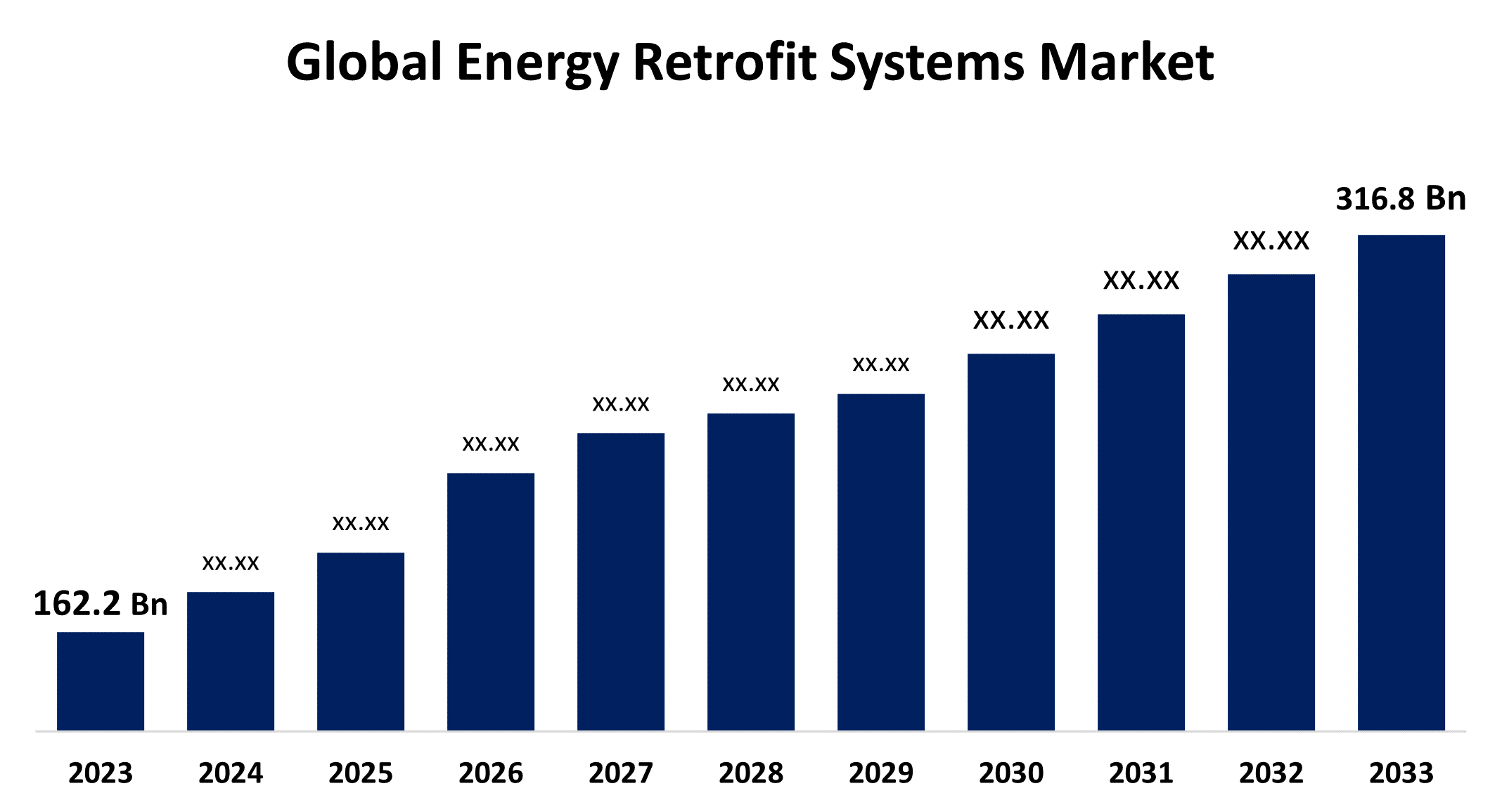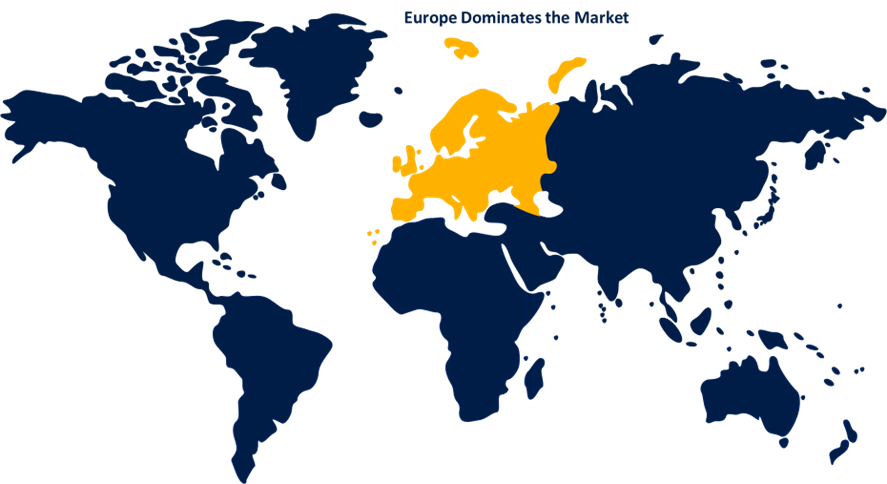Global Energy Retrofit Systems Market Size, Share, and COVID-19 Impact Analysis, By Product (Envelope, LED Retrofit Lighting, HVAC Retrofit, and Appliances), By Application (Residential, Commercial, and Institutional), and By Region (North America, Europe, Asia-Pacific, Latin America, Middle East, and Africa), Analysis and Forecast 2023 - 2033
Industry: Energy & PowerGlobal Energy Retrofit Systems Market Insights Forecasts to 2033
- The Global Energy Retrofit Systems Market Size was Valued at USD 162.2 Billion in 2023
- The Market Size is Growing at a CAGR of 6.92% from 2023 to 2033
- The Worldwide Energy Retrofit Systems Market Size is Expected to Reach USD 316.8 Billion by 2033
- Asia Pacific is Expected to Grow the fastest during the forecast period.

Get more details on this report -
The Global Energy Retrofit Systems Market Size is Anticipated to Exceed USD 316.8 Billion by 2033, Growing at a CAGR of 6.92% from 2023 to 2033.
Market Overview
Energy retrofit systems are upgrades to a building's energy-consuming systems to improve its energy efficiency. Improving the energy efficiency of an existing building through retrofitting makes it easier to heat, enables it to retain heat for longer, and replaces the use of fossil fuels with renewable energy sources. There are numerous benefits to energy retrofitting. For instance, it can lower energy expenses. Additionally, it can decrease carbon emissions and the environmental impact of a home. Furthermore, it can enhance the warmth and dryness of a home in winter and its coolness in summer. Moreover, it can improve the air quality inside the home. It can also reduce issues with dampness, mold, and condensation in the home. Energy retrofitting can raise the value of a home and reduce long-term maintenance and repair costs.
According to the United States Department of Energy, Energy retrofits may employ one or more energy-efficiency measures (EEMs) to maximize inhabitant comfort and reduce building energy use. Energy-efficiency measures EEMs that are frequently implemented in schools include: improving insulation; upgrading heating, ventilation, air conditioning, and water heating systems; plummeting air leakage through air-sealing; installing energy-efficient windows (e.g., insulated glazing units); enhancement to energy-efficient lighting; adding occupancy- or daylight-sensing lighting controls; installing advanced controls and fault diagnostic systems; or changing building operation protocols.
Report Coverage
This research report categorizes the market for energy retrofit systems based on various segments and regions forecasts revenue growth and analyzes trends in each submarket. The report analyses the key growth drivers, opportunities, and challenges influencing the energy retrofit systems market. Recent market developments and competitive strategies such as expansion, product launch, and development, partnership, merger, and acquisition have been included to draw the competitive landscape in the market. The report strategically identifies and profiles the key market players and analyses their core competencies in each sub-segment of the energy retrofit systems market.
Global Energy Retrofit Systems Market Report Coverage
| Report Coverage | Details |
|---|---|
| Base Year: | 2023 |
| Market Size in 2023: | USD 162.2 Billion |
| Forecast Period: | 2023-2033 |
| Forecast Period CAGR 2023-2033 : | 6.92% |
| 2033 Value Projection: | USD 316.8 Billion |
| Historical Data for: | 2019-2022 |
| No. of Pages: | 205 |
| Tables, Charts & Figures: | 110 |
| Segments covered: | By Product, By Application, By Region |
| Companies covered:: | Ballard Power Systems, Plug Power Inc, ITM Power PLC, Intelligent Energy Limited, PowerCell Sweden AB, Cummins Inc., AVL, Nedstack Fuel Cell Technology BV, Horizon Fuel Cell Technologies, Altergy, NUVERA FUEL CELLS, LLC, ElringKlinger AG, Infinity Fuel Cell and Hydrogen, Inc., Doosan Fuel Cell Co., Ltd., Toshiba Corporation, and Others Key Vendors. |
| Pitfalls & Challenges: | COVID-19 Empact,Challenges, Future, Growth, & Analysis |
Get more details on this report -
Driving Factors
Energy retrofit system is widely used in the construction sector to optimize the energy performance of the structure, which consequences in lower utilization of land energy and also reduces the dependency on constructing new buildings. This factor is anticipated to drive this market. Additionally, the adoption of these systems could also help in extending the life of the obtainable building or historical buildings while ensuring optimum thermal comfort for the occupants which leads to higher productivity. Rapid urbanization and industrialization, which is increasing consumer spending on energy retrofit systems. Integration of smart technologies and IoT, which allows for real-time monitoring and optimization of energy use, drives the market.
Restraining Factors
The energy retrofit systems market faces several restraints including, the cost of energy retrofit systems is high due to the cost of research and development, and hidden costs like overhead expenses and potential loss of utility. The return on investment for energy retrofit systems can be gradual, taking three to four years. The energy efficiency gap between investment and implementation is due in part to the behavioral habits of consumers.
Market Segmentation
The energy retrofit systems market share is classified intoproduct and application.
- The envelope segment is estimated to hold the highest market revenue share through the projected period.
Based on the product, the energy retrofit systems market is classified into envelope, LED retrofit lighting, HVAC retrofit, and appliances. Among these, the envelope segment is estimated to hold the highest market revenue share through the projected period. This is attributed to the critical role that building envelopes play in enhancing energy efficiency. Building envelopes, which consist of walls, roofs, windows, and doors, are fundamental in minimizing energy loss and improving thermal comfort within buildings. Advanced materials and technologies used in envelope retrofits, such as high-performance insulation, energy-efficient windows, and reflective roofing, comprehensively reduce heating and cooling demands. This, in turn, leads to substantial energy savings and lower greenhouse gas emissions.
- The commercial segment is anticipated to hold the largest market share through the forecast period.
Based on the application, the energy retrofit systems market is divided into residential, commercial, and institutional. Among these, the commercial segment is anticipated to hold the largest market share through the forecast period. This is due to largely driven by the significant energy consumption associated with commercial buildings, which include offices, retail spaces, hotels, and healthcare facilities. These buildings frequently have high energy demands due to extensive use of lighting, HVAC systems, and other energy-intensive operations. Thus, retrofitting these structures with energy-efficient technologies offers substantial opportunities for energy savings and operational cost reductions.
Regional Segment Analysis of the Energy Retrofit Systems Market
- North America (U.S., Canada, Mexico)
- Europe (Germany, France, U.K., Italy, Spain, Rest of Europe)
- Asia-Pacific (China, Japan, India, Rest of APAC)
- South America (Brazil and the Rest of South America)
- The Middle East and Africa (UAE, South Africa, Rest of MEA)
Europe is anticipated to hold the largest share of the energy retrofit systems market over the predicted timeframe.

Get more details on this report -
Europe is anticipated to hold the largest share of the energy retrofit systems market over the predicted timeframe. This leading position can be attributed to the region's strong regulatory framework and long-standing binder to sustainability and energy efficiency. European countries have implemented stringent energy performance standards and determined climate targets, which drive the demand for energy retrofit systems. The European Union’s policies, such as the Energy Performance of Buildings Directive (EPBD) and the Renovation Wave initiative, aim to extensively improve the energy efficiency of existing buildings across the continent. Moreover, Europe’s focus on reducing greenhouse gas emissions and transitioning to a low-carbon economy has additionally propelled the market, as retrofitting existing structures is seen as a crucial step in achieving these environmental goals. The European nation operates with its unique policies, funding mechanisms, and regional authorities tasked with monitoring national progress according to their commitments. This dedicated approach to efficiency ensures accountability and facilitates counteractive measures when needed. As a result, the sustained demand for energy-efficient products in the market will continue.Top of FormBottom of FormTop of Form
Asia Pacific is expected to grow at the fastest CAGR growth of the energy retrofit systems market during the forecast period. Asia-Pacific area is anticipated to be fueled by lower costs for renewable energy and infrastructure, as well as rapid production of energy modernization systems in the region and adoption of these systems by residential and commercial end users. The regional market for energy retrofits is also being pushed by government regulations and incentives like tax credits and building energy standards. Furthermore, China’s Energy Retrofit Systems market held the largest market share, and the Indian Energy Retrofit Systems market was the fastest-growing market in the Asia-Pacific region.
Competitive Analysis:
The report offers the appropriate analysis of the key organizations/companies involved within the energy retrofit systems market along with a comparative evaluation primarily based on their product offering, business overviews, geographic presence, enterprise strategies, segment market share, and SWOT analysis. The report also provides an elaborative analysis focusing on the current news and developments of the companies, which includes product development, innovations, joint ventures, partnerships, mergers & acquisitions, strategic alliances, and others. This allows for the evaluation of the overall competition within the market.
List of Key Companies
- Ballard Power Systems
- Plug Power Inc
- ITM Power PLC
- Intelligent Energy Limited
- PowerCell Sweden AB
- Cummins Inc.
- AVL
- Nedstack Fuel Cell Technology BV
- Horizon Fuel Cell Technologies
- Altergy
- NUVERA FUEL CELLS, LLC
- ElringKlinger AG
- Infinity Fuel Cell and Hydrogen, Inc.
- Doosan Fuel Cell Co., Ltd.
- Toshiba Corporation
- Others
Key Target Audience
- Market Players
- Investors
- End-users
- Government Authorities
- Consulting And Research Firm
- Venture capitalists
- Value-Added Resellers (VARs)
Recent Developments
- In September 2024, Orion Energy Systems has been awarded projects totaling more than $2M from a longstanding automotive OEM customer. These projects encompass the project management, installation, and commissioning of LED lighting systems across multiple manufacturing facilities in the United States.
- In August 2024, DMF Lighting leading architectural lighting manufacturer launches unique downlighting conversion retrofit kits. They added unique 4-inch LED recessed down lighting conversion kits.
Market Segment
This study forecasts revenue at global, regional, and country levels from 2023 to 2033. Spherical Insights has segmented the energy retrofit systems market based on the below-mentioned segments:
Global Energy Retrofit Systems Market, By Product
- Envelope
- LED Retrofit Lighting
- HVAC Retrofit
- Appliances
Global Energy Retrofit Systems Market, By Application
- Residential
- Commercial
- Institutional
Global Energy Retrofit Systems Market, By Regional Analysis
- North America
- US
- Canada
- Mexico
- Europe
- Germany
- UK
- France
- Italy
- Spain
- Russia
- Rest of Europe
- Asia Pacific
- China
- Japan
- India
- South Korea
- Australia
- Rest of Asia Pacific
- South America
- Brazil
- Argentina
- Rest of South America
- Middle East & Africa
- UAE
- Saudi Arabia
- Qatar
- South Africa
- Rest of the Middle East & Africa
Frequently Asked Questions (FAQ)
-
1. What is the CAGR of the energy retrofit systems market over the forecast period?The energy retrofit systems market is projected to expand at a CAGR of 6.92% during the forecast period.
-
2. What is the market size of the energy retrofit systems market?The Global Energy Retrofit Systems Market Size is Expected to Grow from USD 162.2 Billion in 2023 to USD 316.8 Billion by 2033, at a CAGR of 6.92% during the forecast period 2023-2033.
-
3. Which region holds the largest share of the energy retrofit systems market?Europe is anticipated to hold the largest share of the energy retrofit systems market over the predicted timeframe.
Need help to buy this report?